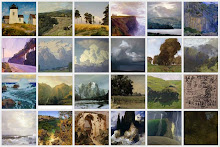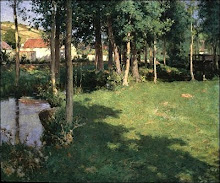
Tuesday, December 27, 2011
Frederic Edwin Church - Ruins
Saturday, November 19, 2011
Fields
Charles Courtney Curran, American, A Breezy Day, 1887
Joaquin Sorolla y Bastida, Spanish, Prado de Asturias (Field in Asturias) 1903.
The simplicity of these two works is very attractive: just green and white with a hint of pink to complement.
A few years ago I bought a tube of cinnabar green light by Rembrandt. It's the best colour I have found for sunlit grass. The grass in the lower painting must have been painted with cinnabar or something close to it.
Rembrandt Cinnabar Green Light
Wednesday, September 14, 2011
AJ Munnings
AJ Munnings (8 October 1878–17 July 1959) is considered one of England's finest equine painters.
He was an opponent of Modernism, and the top landscape is probably too bucolic for contemporary tastes, but this is a beautifully composed and executed landscape. By painting the subject with the light coming from behind him, he is able to use the shadows of the animals to bring out their forms.
Tuesday, August 23, 2011
Susan Downing White
Susan Downing White paints wonderfully poetic evocations of the Gulf Coast of the United States, in a style influenced by 17th century Dutch masters of landscape painting.
Tuesday, August 2, 2011
Architectural Elements
The abstract design possibilities of architectural elements in the landscape has been explored in previous posts, but here are some more examples.
Contrasting rectilinear and organic, natural and man-made elements, increases visual interest. Though there are no trees in the roofscape, the earthen tiles, with their variegated textures, are a kind of natural element.
Black is rare in nature, but architectural elements give a landscape painter a chance to add some punchy accents to their composition.
Klimt integrates architectural and vegetal elements through pattern and texture.
Top: Alexandra Tyng, Golden, Maine, 28 x 42 inches
Middle: Thomas W. Schaller, Roofs Sienna, watercolour.
Bottom: Klimt, Schloss Kammer
Saturday, July 2, 2011
Travel Painting
Edwin Lord Weeks (American, 1849-1903), A Shepherd on a Hillside, Tetuan, 60.3 x 88.5 cm
Painting as a record of travel experiences was a popular genre of the 18th and 19th centuries. Colour photography has greatly reduced the desire for painted records; however, many artists find their work is reinvigorated by travel; and the sketchbooks they bring home may be a valuable resource for paintings.
Edwin Lord Weeks was an American, explorer and painter who specialised in Orientalist scenes encountered on his many travels.
A figure in local attire adds greatly to the evocation of place.
A figure in local attire adds greatly to the evocation of place.
Thursday, June 9, 2011
Google Art Project
I found this work ('Rye') by the Russian painter Ivan Shishkin, on Google Art Project, a wonderful tool that allows you to zoom in to incredibly high resolution images of art in Major Galleries around the world. It's possible to look at the brushstrokes as if you were peering at the painting only a few inches away from the paint surface.
One thing that I noticed right away was how thinly the oil paint was applied in many of the 19th century works. Up close they appeared like watercolours in some areas. In comparison, 20th century paintings tend to have much thicker paint layers.
Close up, you can see finely spattered whitish paint in the sky near the horizon, giving the effect of hazy distance.
There's no substitute for seeing a real painting in a gallery, but this comes very close.
www.googleartproject.com
There's no substitute for seeing a real painting in a gallery, but this comes very close.
www.googleartproject.com
Sunday, April 17, 2011
Alfred William Hunt
Wind of the Eastern Sea, by Alfred William Hunt (1830-96). Watercolour. England, 19th century.
Hunt balances the dark purplish shadows of the cliffs with the golden light of the sun on the horizon.
Saturday, April 9, 2011
Saturday, March 26, 2011
Dream
A dream-like depiction of the Australian landscape by Gordon Robinson. Though demonstrating a deep understanding of 'real' landscapes, this kind of painting draws from memory, imagination and dreams.
The stream leads us into the inner world.
Blue and mauve shadows are contrasted to yellow rocks and the stamens of native grass trees.
Tuesday, March 15, 2011
Prince Eugen
The Cloud, 1896
Prince Eugen was the son of the Swedish king and queen. He took up painting as a career, and was no mere royal dilettante. His parents, perhaps surprisingly for someone in his position, supported his decision.
Tuesday, March 8, 2011
Monday, February 28, 2011
Gardens
The garden is another rich traditional sub-genre of landscape painting.
I love the intense greens in this work by the Spanish painter Juan Manuel Fernandez Pinedo.
Gardens were a favourite subject of Vuillard and Klimt, flowerbeds and gravel paths fulfilling their love of pointillist pattern and colour:
Australian painter, Ric Amor, combines plant forms, statuary and built elements in this work reminiscent of moderns such as Picasso and Le Corbusier.
Gardens were a favourite subject of Vuillard and Klimt, flowerbeds and gravel paths fulfilling their love of pointillist pattern and colour:
Australian painter, Ric Amor, combines plant forms, statuary and built elements in this work reminiscent of moderns such as Picasso and Le Corbusier.
Thursday, February 17, 2011
Dennis Doheny
The use of luminous mist behind trees is a clever device. Particularly when working in fine detail, you need mysterious nebulous areas to breathe life into the painting.
Sunday, January 30, 2011
Len Chmiel
Sizes: 16 x 22, 12 x 12 inches
Len Chmiel states on his website that he aims to convey the subtle beauty of nature without being too literal. He tries to push the boundaries of reality rather than just depicting it.
I love the sensitive painterliness and mark-making in these works.
Friday, January 21, 2011
Magic Realism
Rockwell Kent, American, 1882-1971, lilacs, c 1968, 24 x 34 inches.
In works of fantasy or surrealist art the supernatural is usually immediately obvious, but in Magic Realsim a dream-like or mythic dimension is only subtly implied within a realist framework.
Formalist qualities such as the centrally placed figure, simplified repeated forms, and the roof lines converging at the point of interest, where the flower is being plucked, produce a kind of dream-like, surreal or magic realist effect. They are a little too synchronistic to be true.
The subject is apparently mundane, but the formality, and stage-like lighting, suggest an event of mythic importance or something occurring in a dream, the significance of which escapes the conscious mind.
A touch of Magic Realism can give a landscape a fascinating edginess.
Sunday, January 9, 2011
Buildings
Buildings can give a landscape painting a geometrical element or pattern, an opportunity to introduce colours and shapes not found in nature.
The proportion of built to natural environment can be played with. These two landscape paintings have an almost even balance between buildings and nature, creating an interesting tension.
The townscape or cityscape, is a subgenre of landscape painting that emerged in the seventeenth century.
The top image is a detail from a painting by the Danish artist Christen Kobke.
The lower work is unknown.
Subscribe to:
Posts (Atom)








































.jpg)













+1900.bmp)